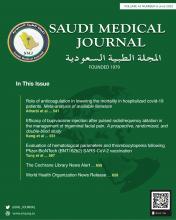Article Figures & Data
Tables
Characteristics n % Gender Female 58 47.7 Male 53 52.3 Age groups ≤44 years: young adult 45 40.5 45-59 years: middle-aged 42 37.8 60-74 years: old 21 18.9 75-79 years: elderly 3 2.7 Body mass index distribution 18.5-24.9 kg/m2: adequate weight 30 27 25-29.9 kg/m2: overweight 42 37.8 30-34.99 kg/m2: obese 26 23.4 35-39.99 kg/m2: moderate obese 11 9.9 40-49.99 kg/m2: morbid obese 2 1.8 Education status Illiterate 3 2.7 Primary education 29 26.1 Secondary education 5 4.5 High school 25 22.5 University 49 44.1 Smoking status Never smoked 88 79.3 Quitted 5 4.5 Smokes 18 16.2 Exercise habit No 70 63.1 Yes 41 36.9 Hypertension diagnosis No 87 78.4 Yes 24 21.6 Diabetes diagnosis No 88 79.3 Yes 23 20.7 Coronary artery disease diagnosis No 105 94.6 Yes 6 5.4 Clinical classification Mild 58 52.3 Moderate and severe 53 47.7 Classification based on computed tomography Normal lung image 37 33.3 Mild lung involvement 37 33.3 Moderate lung involvement 37 33.3 - Table 2
- Correlation analysis results. The relationship between the questionnaire scores used in the evaluation and the patient’s age and body mass index was clarified with the results of the correlation analysis.
Variables Age (year) BMI (kg/m2) IPAQ Total score (MET) Beck anxiety inventory score Fatigue severity scale score PSQI Subjective sleep quality Age (year) 1 #x00A0; #x00A0; #x00A0; #x00A0; #x00A0; BMI (kg/m2) 0.000**
0.374(r)1 #x00A0; #x00A0; #x00A0; #x00A0; IPAQ total score (MET) 0.003**
0.972(r)0.398
0.081(r)1 #x00A0; #x00A0; #x00A0; Beck anxiety inventory score 0.803
-0.024(r)0.421
-0.077(r)0.526
-0.054(r)1 #x00A0; #x00A0; Fatigue severity scale score 0.054
0.184(r)0.784
-0.026(r)0.296
-0.164(r)0.000**
0.445(r)1 #x00A0; PSQI subjective sleep quality 0.663
0.042(r)0.394
-0.082(r)0.498
-0.065(r)0.000**
0.476(r)0.000**
0.347(r)1 PSQI sleep onset latency 0.686
0.039(r)0.998
0.000(r)0.500
-0.065(r)0.000**
0.396(r)0.215
0.119(r)0.000**
0.384(r)PSQI sleep duration 0.547
-0.058(r)0.158
0.135(r)0.731
0.033(r)0.863
-0.017(r)0.186
-0.127(r)0.364
0.087(r)PSQI sleep efficiency 0.514
0.063(r)0.512
0.063(r)0.139
-0.141(r)0.686
0.039(r)0.817
-0.022(r)0.265
0.107(r)PSQI sleep disturbances 0.428
0.076(r)0.533
0.060(r)0.538
-0.059(r)0.000**
0.487(r)0.054
0.183(r)0.001**
0.319(r)PSQI use of sleeping medication 0.652
-0.043(r)0.613
-0.049(r)0.613
0.048(r)0.025*
0.212(r)0.495
0.065(r)0.030*
0.206(r)PSQI daytime dysfunction 0.259
-0.108(r)0.312
-0.097(r)0.160
-0.134(r)0.000**
0.533(r)0.055
0.183(r)0.000**
0.495(r)PSQI total score 0.835
0.020(r)0.752
0.030(r)0.354
-0.184(r)0.000*
0.215(r)0.039*
0.193(r)0.000**
0.620(r)*Correlation is significant at the 0.05 level (2-tailed). **Correlation is significant at the 0.01 level (2-tailed). r: correlation efficient, BMI: body mass index, PSQI: Pittsburgh Sleep Quality Index, MET: metabolic equivalent, BMI: body mass index - Table 2
- Correlation analysis results. The relationship between the questionnaire scores used in the evaluation and the patient’s age and body mass index was clarified with the results of the correlation analysis (continuation).
Variables PSQI sleep onset latency PSQI sleep duration PSQI sleep efficiency PSQI sleep disturbances PSQI Use of sleeping medication PSQI dDaytime dysfunction PSQI total score Age (year) #x00A0; #x00A0; #x00A0; #x00A0; #x00A0; #x00A0; #x00A0; Body mass index (kg/m2) #x00A0; #x00A0; #x00A0; #x00A0; #x00A0; #x00A0; #x00A0; IPAQ total score (MET) #x00A0; #x00A0; #x00A0; #x00A0; #x00A0; #x00A0; #x00A0; Beck anxiety inventory score #x00A0; #x00A0; #x00A0; #x00A0; #x00A0; #x00A0; #x00A0; Fatigue severity scale score #x00A0; #x00A0; #x00A0; #x00A0; #x00A0; #x00A0; #x00A0; PSQI subjective sleep quality #x00A0; #x00A0; #x00A0; #x00A0; #x00A0; #x00A0; #x00A0; PSQI sleep onset latency 1 #x00A0; #x00A0; #x00A0; #x00A0; #x00A0; #x00A0; PSQI Sleep duration 0.383
0.084(r)1 #x00A0; #x00A0; #x00A0; #x00A0; #x00A0; PSQI sleep efficiency 0.383
0.084(r)0.000**
0.603(r)1 #x00A0; #x00A0; #x00A0; #x00A0; PSQI sleep disturbances 0.000**
0.360(r)0.713
-0.035(r)0.594
0.051(r)1 #x00A0; #x00A0; #x00A0; PSQI use of sleeping medication 0.004**
0.274(r)0.218
0.118(r)0.419
0.078(r)0.441
0.074(r)1 #x00A0; #x00A0; PSQI daytime dysfunction 0.000**
0.388(r)0.345
0.090(r)0.055
0.183(r)0.000**
0.414(r)0.009**
0.249(r)1 #x00A0; PSQI total score 0.000**
0.652(r)*0.000
0.507(r)0.000**
0.537(r)0.000**
0.576(r)0.000**
0.452(r)0.000**
0.647(r)1 *Correlation is significant at the 0.05 level (2-tailed). **Correlation is significant at the 0.01 level (2-tailed). r: correlation efficient, BMI: body mass index, PSQI: Pittsburgh Sleep Quality Index, MET: metabolic equivalent - Table 3
- Comparison of age, body mass index, IPAQ total score, fatigue severity scale total score, beck anxiety inventory score, and PSQI scale total score against computed tomography classification.
Computed tomography classification Mean SD P-value Age (year) Normal lung (37 patients) 38.35 13.87 0.004** Mild lung involvement (37 patients) 50.56 12.93 Moderate lung involvement 52.72 13.13 Total: 111 patients Body mass index (kg/m2) Normal lung (37 patients) 26.77 5.01 0.040* Mild lung involvement (37 patients) 26.96 4.72 Moderate lung involvement 29.72 5.57 Total: 111 patients IPAQ total score (MET) Normal lung (37 patients) 1016.40 1761.99 0.238 Mild lung involvement (37 patients) 768.36 1708.06 Moderate lung involvement 960.98 1669.64 Total: 111 patients Fatigue severity scale total score Normal lung (37 patients) 3.30 1.44 0.786 Mild lung involvement (37 patients) 3.58 1.67 Moderate lung involvement 3.70 1.80 Total: 111 patients Beck anxiety inventory score Normal lung (37 patients) 8.94 8.22 0.826 Mild lung involvement (37 patients) 9.45 8.44 Moderate lung involvement 9.32 7.14 Total: 111 patients PSQI scale total score Normal lung (37 patients) 3.64 2.27 0.420 Mild lung involvement (37 patients) 4.51 3.32 Moderate lung involvement 4.81 3.57 Total: 111 patients *Correlation is significant at the 0.05 level (2-tailed). **Correlation is significant at the 0.01 level (2-tailed). r: correlation efficient, PSQI: Pittsburgh Sleep Quality Index, MET: metabolic equivalent, SD: standard deviation - Table 4
- Comparison of age, body mass index, IPAQ total score, fatigue severity scale total score, beck anxiety inventory score, and PSQI scale total score against clinical classification.
Clinical classification Mean SD P-value Age (year) Mild (58 patients) 42.81 14.96 <0.01** Moderate or severe (53 patients) 52.03 12.78 Total: 111 patients Body mass index (kg/m2) Mild (58 patients) 27.23 4.75 <0.01** Moderate or severe (53 patients) 29.86 5.41 Total: 111 patients IPAQ total score (MET) Mild (58 patients) 1878.22 246.62 0.993 Moderate or severe (53 patients) 1502.10 206.32 Total: 111 patients Fatigue severity scale total score Mild (58 patients) 3.29 1.57 0.112 Moderate or Severe (53 patients) 3.78 1.68 Total 111 patients Beck anxiety inventory score Mild (58 patients) 8.13 7.66 0.124 Moderate or Severe (53 patients) 10.45 8.03 Total 111 patients *Correlation is significant at the 0.05 level (2-tailed). **Correlation is significant at the 0.01 level (2-tailed). r: correlation efficient, PSQI: Pittsburgh Sleep Quality Index, MET: metabolic equivalent, SD: standard deviation,






